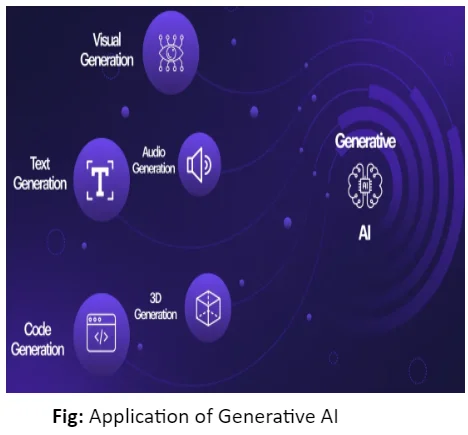Generative AI, a branch of artificial intelligence, is making waves with its ability to create new content across various media, including text, images, audio, and even code. While its potential for revolutionizing industries and creative fields is undeniable, it also raises critical questions about learning curves, authenticity, copyright, human rights, and the ethical implications of technologies like deepfakes.
Generative AI: Transforming Content Creation, Media, Healthcare, and Beyond
Applications of Gen AI
-
- Generative AI, exemplified by models like ChatGPT by OpenAI, Bard by Google and Other AI based tools, is revolutionizing content creation across text, images, audio, and code. It enhances creativity, efficiency, and personalization in various industries, from media production to healthcare.
-
- Text Generation: Generative AI models like GPT-3 can generate coherent and contextually relevant text.
- This is utilized in content creation, including article writing, social media posts, and creative writing.
- Code Generation: Developers use generative models to automatically generate code snippets, aiding in software development and reducing coding time.
- Automated Storytelling: Generative AI can create narratives, scripts, and storylines for various media, contributing to the entertainment industry.

- Media Production and Design
-
- Image Synthesis: Models like DALL-E by OpenAI can generate images from textual descriptions.
- This is valuable in graphic design, conceptualizing ideas, and creating visual content.
- Style Transfer: Generative AI can apply artistic styles to images, videos, or other media, enhancing creativity in visual production.
- Video Game Design: Generative models assist in creating characters, landscapes, and scenarios in video games, providing a dynamic and immersive gaming experience.
-
- Drug Discovery: Generative models aid in predicting molecular structures and generating potential drug compounds, accelerating the drug discovery process.
- Medical Imaging: Generative AI enhances medical image interpretation, assisting in the diagnosis of diseases and abnormalities through automated analysis and report generation.
-
- Music Composition: Generative AI can compose music, generating melodies, harmonies, and even entire pieces.
- This has applications in the music industry for creating original compositions.
- Virtual Characters: In the film and animation industry, generative models contribute to the creation of virtual characters, bringing new possibilities to special effects and animation.
-
- Content Personalization: Generative AI helps personalize marketing content, creating tailored messages and advertisements based on user preferences and behavior.
- Chatbots and Virtual Assistants: Natural language generation allows for the creation of intelligent chatbots and virtual assistants that can understand and respond to user queries effectively.
-
- Automated Tutoring: Generative AI facilitates the creation of interactive educational content, including automated tutoring systems that adapt to individual learning styles.
- Content Summarization: Generative models can summarize large volumes of text, making it easier for students and researchers to grasp key information.
-
- Virtual Environments: Generative AI contributes to the development of realistic virtual environments for training purposes, such as flight simulations, medical procedures, and military training.
Conclusion
- Generative AI is reshaping content creation, media production, healthcare, entertainment, business, education, and simulation.
- From generating text and images to aiding in drug discovery and personalized marketing, its applications are vast and varied.
- As generative AI continues to evolve, it offers incredible opportunities while necessitating careful consideration of ethical and practical issues to ensure its responsible and beneficial use.
![]() June 11, 2024
June 11, 2024
![]() 623
623
![]() 0
0
